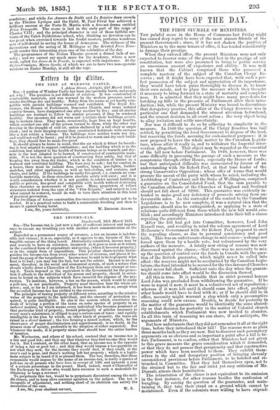Pflug iii lht nib%
THE FIRE AT WINDSOR CASTLE.
1 Adam Street, Adelphi, 22d March 1853. Sin--A portion of Windsor Castle has been unexpectedly burnt, and people ask why ? The question is not difficult of solution. It was constructed of combustible materials, and was warmed by the modern processes used to render dwellings dry and healthy. Safety from fire seems as yet hardly com- patible with ancient buildings warmed and ventilated. The Royal Ex- change, the Houses of Parliament, Doncaster Church, and many isolated country-houses, have disappeared one after another by fire ; and all similar buildings are destined to follow by similar processes if they be rendered healthy. Our ancestors did not warm and ventilate their buildings accord- ing to modern ideas. They made, occasionally, huge fires on huge hearths, which scorched one side of the person turned to them, while the other was freezing in the draught of cold air, unless sheltered by a tall chair or ample cloak ; and in their sleeping-rooms they constructed bedsteads with curtains like a tent within a fortress. The buildings were neither warm nor dry, and could not well be burnt ; and if it be desired to warm and dry such build- ings, they should first be made fire-proof.
It should always be borne in mind, that the air which is fittest for breath- ing is best adapted to support combustion ; and the building which is in the condition best adapted to the health of human beings as to warmth and dry- ness is the best adapted to be burned, if constructed of combustible mate- rials. It is not the mere question of constructing flues safely, but that of keeping fire away from dry tinder, which is the condition of timber in a warmed and ventilated building. The flues may be safe ; but for comfort in a house, there must be radiant fires, candles, lamps, gas-lights, lucifer- matches, and other appliances, as well as bed-clothes, and curtains, and chairs, and tables. If the buildings be really fire-proof, i. e. contain no com- bustible materials, in these structures absolute safety will exist ; and it is worth consideration whether it is not possible to render ancient buildings, public or private, fire-proof and compatible with health without destroying their character as monuments of the past. Many proprietors of valued structures isolated from the care of the "Fire Brigade," and subject to lose what cannot be restored, would do well to turn their attention to this kind of practical prevention. For dwellings of future construction fire-insurance offices ought not to be needed. It is a practical satire to build a combustible dwelling and then to insure it against being burnt.


























 Previous page
Previous page